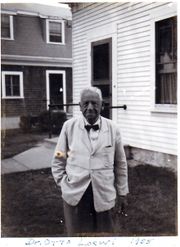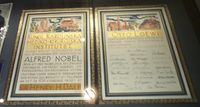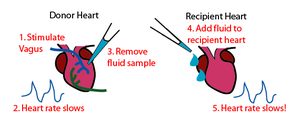اوتو لوڤي
اوتو لوڤي Otto Loewi | |
|---|---|
 | |
| وُلِدَ | يونيو 3, 1873 |
| توفي | ديسمبر 25, 1961 (aged 88) |
| القومية | النمسا, ألمانيا, الولايات المتحدة |
| المدرسة الأم | جامعة ستراسبورگ |
| عـُرِف بـ | أستيلكولين Acetylcholine |
| الجوائز | جائزة نوبل في الفسيولوجيا أو الطب (1936) |
| السيرة العلمية | |
| المجالات | فارماكولوجيا |
اوتو لوڤي (Otto Loewi) (و.3 يونيو 1873 - ت. 25 ديسمبر 1961) هو صيدلي نمساوي، اكتشافه أستيلكولين ساعد على تحسين العلاج الطبي، مما أهله للحصول على جائزة نوبل في الطب لعام 1936، بالمشاركة مع هنري ديل. ويشار إليه على أنه "أبو علم الأعصاب".
السيرة الذاتية
بحوث

قبل تجارب لوڤي، لم يكن واضحاً إذا ما كانت الإشارات عبر المشبك العصبي بيوكهربية أم كيميائية. تجربة لوڤي الشهيرة، المنشورة في 1921، أجابت إلى حد كبير على هذا السؤال. فحسب لوڤي، فكرة هذه التجربة الهامة أتته في المنام. فقد شرَّح من ضفدعتين قلبين نابضين: one with the vagus nerve which controls heart rate attached, the other heart on its own. Both hearts were bathed in a saline solution (i.e. Ringer's solution). By electrically stimulating the vagus nerve, Loewi made the first heart beat slower. Then, Loewi took some of the liquid bathing the first heart and applied it to the second heart. The application of the liquid made the second heart also beat slower, proving that some soluble chemical released by the vagus nerve was controlling the heart rate. He called the unknown chemical Vagusstoff. It was later found that this chemical corresponded to Acetylcholine (Kandel, et al. 2000).
Loewi's investigations “On an augmentation of adrenaline release by cocaine” and “On the connection between digitalis and the action of calcium” were profound concepts and were studied relentlessly by others decades later.
He also clarified two mechanisms of eminent therapeutic importance: the blockade and the augmentation of nerve action by certain drugs.
He is almost as famous for the means by which the idea for his experiment came to him as he is for the experiment itself. On Easter Saturday 1923, he dreamed of an experiment that would prove once and for all that transmission of nerve impulses was chemical, not electrical. He woke up, scribbled the experiment onto a scrap of paper on his night-stand, and went back to sleep.
The next morning he arose very excited because he knew this dream had been very important. But he found, to his horror, that he couldn't read his midnight scribbles. That day, he said, was the longest day of his life, as he could not remember his dream. That night, however, he had the same dream. This time, he immediately went to his lab to perform the experiment.[1] From that point on, the consensus was that the Nobel was not a matter of "if" but of "when."
Thirteen years later, Loewi was awarded the Nobel Prize in Physiology or Medicine, which he shared with Sir هنري هالت ديل.
المصادر
- ^ O. Loewi (1921) "Über humorale Übertragbarkeit der Herznervenwirkung. I." Pflügers Archiv, 189, pp. 239–242 doi:10.1007/BF01731235
- Raju, T N (1999), "The Nobel chronicles. 1936: Henry Hallett Dale (1875-1968) and Otto Loewi (1873-1961).", Lancet 353 (9150): 416, 1999 Jan 30, PMID 9950485
- Lembeck, F (1973), "[Otto Loewi--a scientist against his contemporary background (author's transl)]", Wien. Klin. Wochenschr. 85 (42): 685–6, 1973 Oct 19, PMID 4587917
- Babskiĭ, E B (1973), "[Otto Loewi (on the 100th anniversary of his birth]", Fiziologicheskiĭ zhurnal SSSR imeni I. M. Sechenova 59 (6): 970–2, 1973 Jun, PMID 4583680
وصلات خارجية
- Nobel Lectures, Physiology or Medicine 1922-1941, Elsevier Publishing Company, Amsterdam, 1965.
- Kandel ER, Schwartz JH, Jessell TM. Principles of Neural Science, 4th ed. McGraw-Hill, New York (2000). ISBN 0-8385-7701-6
- Otto Loewi Biography. Nobel Foundation.
- Sabbatini, R.M.E.: Neurons and synapses. The history of its discovery. IV. Chemical transmission. Brain & Mind, 2004.
- Pages using infobox scientist with unknown parameters
- Articles with hatnote templates targeting a nonexistent page
- مواليد 1873
- وفيات 1961
- علماء يهود
- مخترعون يهود
- علماء أعصاب أمريكان
- علماء أعصاب ألمان
- علماء الصيدلة
- حائزو جائزة نوبل في الطب
- حائزو جائزة نوبل ألمان
- حائزو جائزة نوبل يهود
- خريجو جامعة ميونخ
- خريجو جامعة ستراسبورگ
- طاقم تدريس جامعة ستراسبورگ
- ألمان مغتربون في النمسا
- يهود مهاجرون إلى الولايات المتحدة
- مواطنون مجنسون في الولايات المتحدة
- يهود ألمان
- يهود ألمان-أمريكان
- أشخاص من فرانكفورت
- أشخاص من هسه-ناساو
